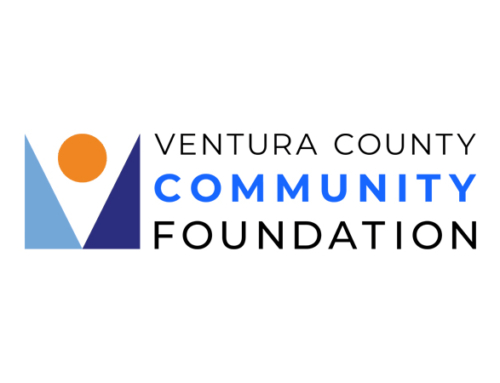The market for talented workers is tight as is – and for non-profit organizations, the recruitment and retaining of talent is even harder, due to the constraints of being a not-for-profit organization. These organizations aim to devote as much as possible towards the cause or goal of their mission, which can sometimes create a squeeze.
In a recent report by Nonprofit HR, nonprofits cited a number of challenges when it comes to dealing with staffing challenges. The results may be surprising – retention is not the biggest concern. Instead, it is the hiring process that holds the most obstacles for nonprofits. Of course, retention is still a fairly big issue, particularly as the cost of living generally rises every year while budgets don’t. So what are nonprofits dealing with, and what are potential solutions to the recruiting and retaining difficulties?
Recruiting Talent
Getting out there and finding the right talent is the first challenge a nonprofit needs to overcome – and boy is it a hill to climb. Newly-minted graduates come with newly-minted student loan payments and are looking to get a job that pays them off as soon as possible. They also are utilizing different ways of searching for jobs. Connecting with this talent needs to be a primary concern.
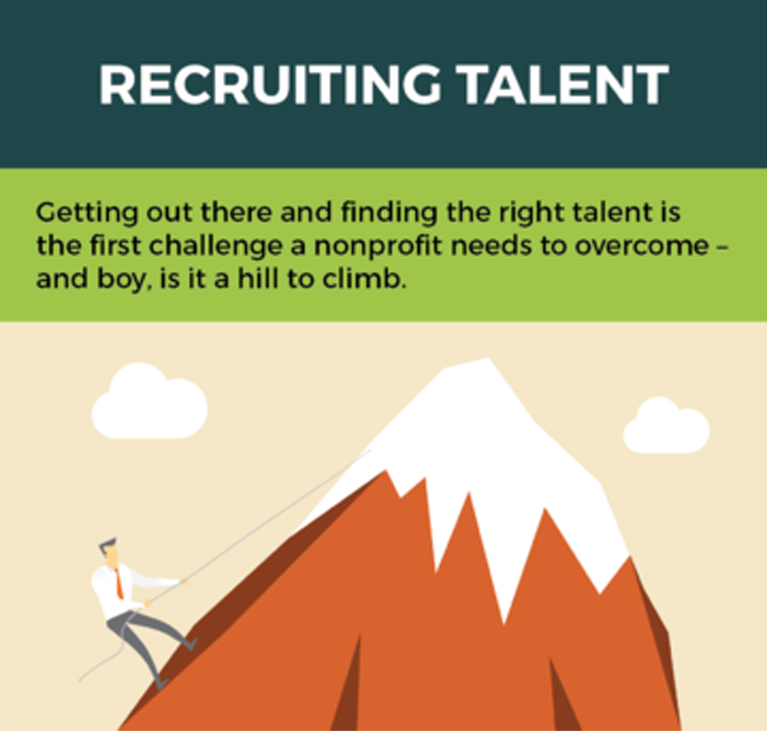
The report cites concerns at the recruitment level as making up over 75% of the staffing challenges faced by nonprofits. It is difficult to find qualified staff, difficult to hire said qualified staff within budget constraints, difficult to find the time to conduct the talent search, and difficult to make the hiring decision in a short amount of time.
Finding Qualified Staff

One of the great ways a nonprofit can improve recruiting is by investing time in alternative recruitment efforts. Paid advertisements and announcements aren’t the way to the heart of the new generation. Instead, use savvy digital recruitment efforts through low-cost and free avenues such as social media, e-mails, or landing pages. The latest generation is using mobile phones, apps, and social media freely, and is more likely to search and apply for jobs this way. Sites such as Idealist and Catchafire make it easy to find passionate nonprofit-oriented individuals who are looking to get working.
Hiring Within Budget Constraints
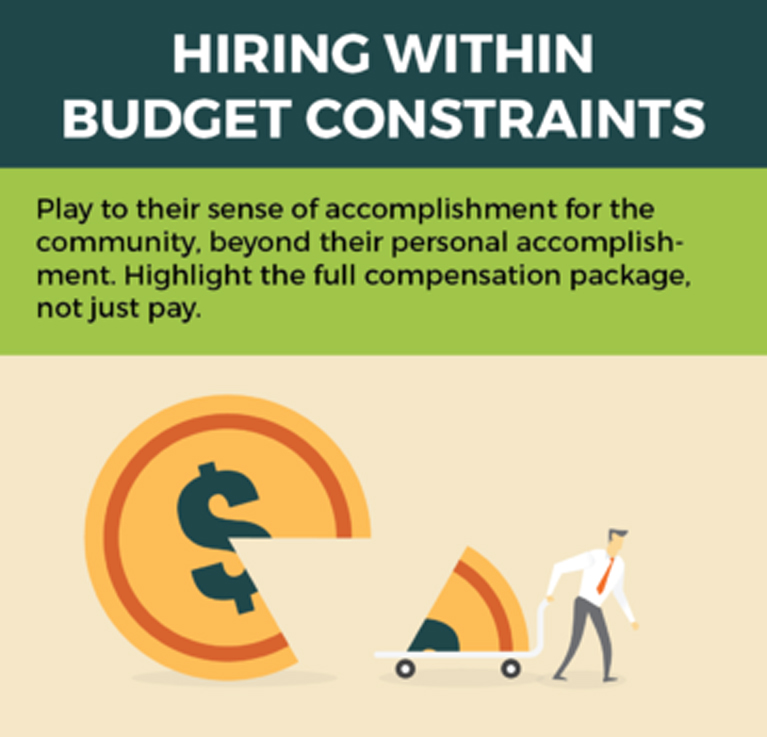
We’ll delve further into this later, but when addressing budgetary constraints, the best bet is to put a salary on the back burner. Instead, play towards the characteristics that have brought them to a nonprofit, to begin with. Play to their sense of accomplishment for the community, beyond their personal accomplishment. Highlight the full compensation package, not just pay. Emphasize the level of employee engagement – every human being wants to be seen and heard, and contribute.
Finding the Time
Nonprofit organizations looking to hire are already strapped for time and talent – entering the hiring process puts an even greater strain on both. Most organizations look at recruitment as an additional duty, not a duty considered as part of the every-day tasks. There will always be a time investment, but a nonprofit can set itself up to reduce this investment as hiring cycles to pass.
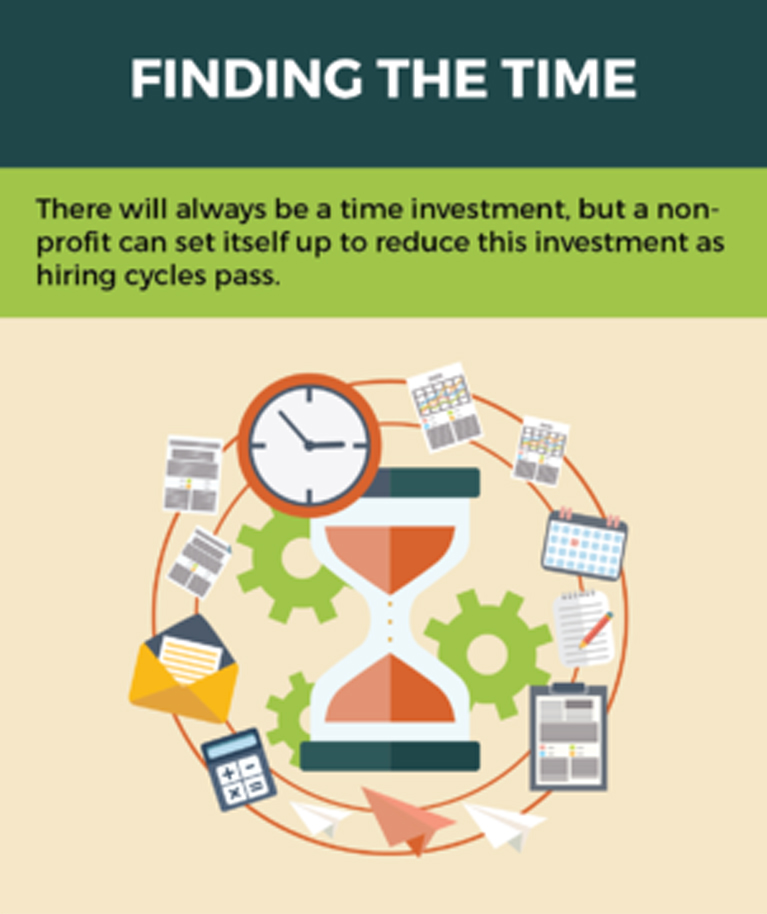
For instance, creating a replicable, repeatable process will go a long way. Write up job descriptions, and maintain them as that job evolves. Even if it is not currently open, updating it on the fly means that when you need to hire, the description is page-ready. Create evaluation sheets for prospective employees, and consider putting together a hiring committee instead of lumping everything on one person. All of these can cut down the time impact on an individual, and the organization as a whole.
Retaining Talent
Even after recruiting and developing talent, nonprofits still face the challenge of retaining them into the future. Surprisingly, the previously-cited report noted that retaining entry-level staff is more difficult than retaining mid- or senior-level staff. What makes the percentages cited in the previous report even more shocking is that, even though retention only accounts for 13% of the staffing challenges faced, the same report indicates that 85% of nonprofits do not have any formal retention strategy! Nearly 60% don’t have any sort of succession plan as employees age out either.
Without a formal retention strategy, an organization can flounder and fall into a cycle of turnover, which means constant hiring costs. This needs to be kept in mind when working with an employee who you may think is leaving – what will it cost to replace her or him? Not just salary, but the time and money the process itself will incur. The lack of retention strategy can also damage employee morale, as if they do not see an effort to retain valuable co-workers, they may start to question what their worth is to the organization.
What is a Nonprofit to Do?
So what can a nonprofit do to acquire and retain talent? There are a number of options out there, but finding what works best can be challenging.
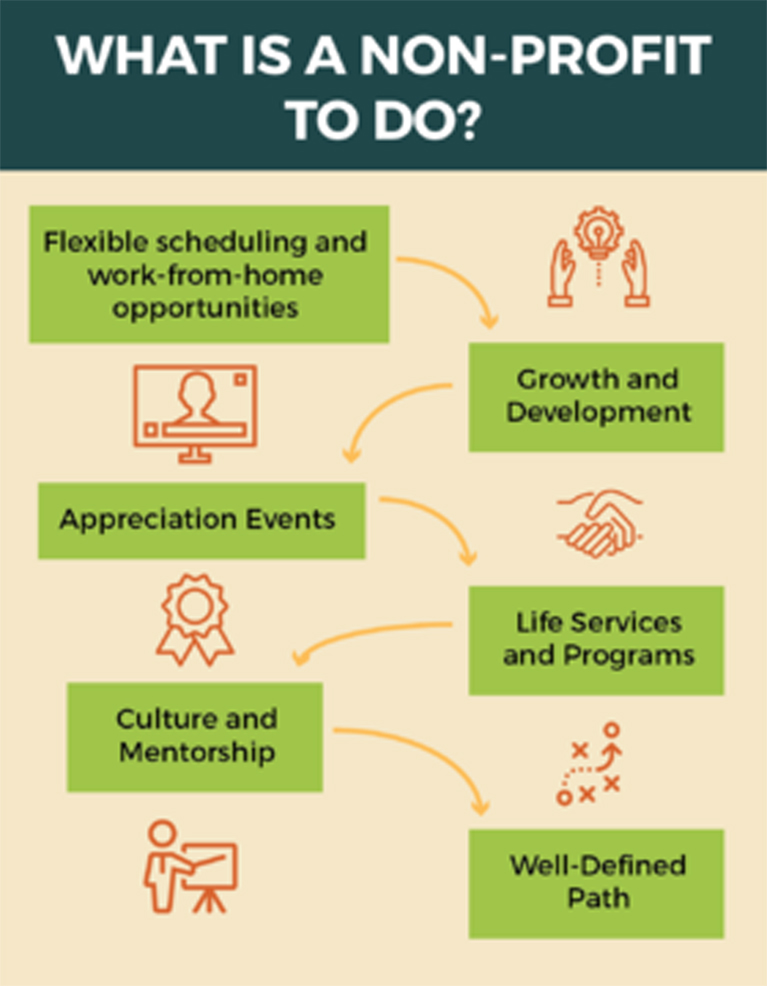
- Flexible scheduling and work-from-home opportunities – By providing the chance for the worker to set their own hours (within reason of course) or a choice of where to work, a nonprofit can offer an advantage that many for-profit companies will not. These opportunities can ease pressures and costs for potential talent. Commutes can be shortened or eliminated. Child-care costs can be reduced. Scheduling errands and appointments will be easier and less stressful. In a recent poll, 37% of Millennials surveyed – the prime target for new hires – have said that they would take a salary reduction of 6-12% for flexible scheduling.
- Growth and Development – Investing further in employees by providing professional development and education opportunities demonstrates that nonprofit values them. Valued employees are more likely to be happy employees, and may be willing to overlook the impossibility of a pay raise in the near future. Educational opportunities can be used to groom newer talent, teaching them skills they may not have had when they came on board. It can also provide organizational flexibility by cross-training workers.
- Appreciation Events – By leveraging space and connections, nonprofits can put on private events for their staff, friends, and family, as an added bonus. This could mean anything from a private picnic to arts or theater performances, to sporting events. By working with other nonprofits and the community that often benefits from their work, nonprofits can capitalize on goodwill.
- Life Services and Programs – Making ends meet on a nonprofit salary can certainly be difficult, and plenty of new hires may not have the experience of managing their finances on their own – a nonprofit could see about retaining the services of a certified financial planner for individual or group consulting. Health and wellness are also important to workers. Offering a reduced-cost or free gym membership or on-site facilities will be a welcome perk. Mental health counseling also falls under that umbrella – it is often an overlooked aspect of a worker’s overall health. Added bonus? By offering these to your workers, you may improve performance. Studies have shown that financial, mental, and physical health all affect the performance of workers.
- Culture and Mentorship – In the CNBC article cited above, other reasons why Millennials would switch jobs – and potentially take a pay cut in doing so – including these factors. Culture is a major player, as workers want to recognized as part of the team, and valued as almost a family members. An employee number on a badge shouldn’t be the extent of an employee’s connection to the company and others. This means encouraging employees to mix with each other, take lunch together, and become more than just cubicle neighbors. This can even include mentoring, as experienced employees take others under their wing. Don’t confuse experience with age either, as older employees may be able to learn newer skills under the mentorship of younger employees.
- Well-Defined Path – For many workers, uncertainty is what leads them to search elsewhere. Setting out well-defined career paths, updating the workers on their progress regularly, and providing the appropriate appreciation lets employees know where they stand and what they have to gain. It’s great peace of mind to be able to see and hear those from an employer.
Let’s face it, the very nature of the marketplace means it will never be easy for nonprofits to recruit and retain top talent. There will always be better opportunities, particularly for talent that places salary at the top of their list. That said, the new generation is offering a lot of hope for nonprofits, as more and more often the new workers are valuing much more than just their pay rate when it comes to looking for a job, or sticking it out at one.



